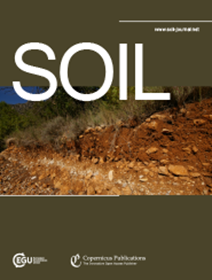Do morphological hillslope features affect soil properties and processes promoting chestnut ink disease? The study case of the Northern Apennine mountains
IF 4.3
2区 农林科学
Q1 SOIL SCIENCE
引用次数: 0
Abstract
Abstract. Ink disease caused by the soil-borne Phytophthora cambivora and Phytophthora cinnamomi is threatening sweet chestnut (Castanea sativa) groves in Europe. This study aims to explore whether soil morphology and its related properties influence the development of chestnut ink disease considering the whole soil depth. In C. sativa stand in Northern Italy, along a small altitudinal transect, soil profiles were dug close to ink diseased plants (INK1 at 978 m a.s.l.) and healthy plants (INK2 988 m a.s.l. and INK3 at 998 m a.s.l.) and each soil horizon evaluated for its properties. Further, INK1, INK2 and INK3 had a slope of 3, 9 and 30 %, respectively. The results showed that the lower slope position of INK1 combined with the lower slope gradient than INK2 and INK3 might have promoted the transport of clay particles and water from the latters to the former. Such process allowed the accumulation of clay within the whole INK1 soil profile increasing the saturated hydraulic conductivity and the wilting point. Such soil features might promote the water accumulation within the deeper soil horizons of INK1 which would explain the presence of Phytophthora spp. DNA. The presence of the root pathogen in INK1 might have affected the microbial functionality as observed by the higher abundance of the contact and medium-distance exploration ectomycorrhizal fungal community than the long-distance types. Finally, such study highlighted the pivotal role of soil processes (i.e., clay and water transport) to shape the soil microbial community and soil-borne pathogens because of the changes of edaphic properties.坡地形态特征是否影响土壤性质和促进板栗病的过程?北亚平宁山脉的研究案例
摘要。由土壤传播的cambivora和Phytophthora cinnamomi引起的墨汁病正在威胁欧洲甜栗树(Castanea sativa)树林。本研究旨在探讨土壤形态及其相关性质是否在考虑全土壤深度的情况下影响板栗墨病的发展。在意大利北部的sativa林分,沿着一个小的垂直样带,在病株(INK1,海拔978 m)和健康株(INK2,海拔988 m和INK3,海拔998 m)附近挖掘土壤剖面,并对每个土壤层的性质进行评价。此外,INK1、INK2和INK3的斜率分别为3%、9%和30%。结果表明,INK1较低的坡位,加之INK2和INK3较低的坡度,可能促进了黏土颗粒和水分从INK2和INK3向INK1的运移;这一过程使粘土在整个INK1土剖面内积累,增加了饱和水力导率和萎蔫点。这种土壤特征可能促进了INK1在较深土层内的水分积累,这可能解释了疫霉菌DNA的存在。INK1中接触型和中距离型外生菌根真菌群落的丰度高于远距离型,根系病原菌的存在可能影响了微生物功能。最后,该研究强调了由于土壤性质的变化,土壤过程(即粘土和水的运输)在塑造土壤微生物群落和土传病原体方面的关键作用。
本文章由计算机程序翻译,如有差异,请以英文原文为准。
求助全文
约1分钟内获得全文
求助全文
来源期刊

Soil
Agricultural and Biological Sciences-Soil Science
CiteScore
10.80
自引率
2.90%
发文量
44
审稿时长
30 weeks
期刊介绍:
SOIL is an international scientific journal dedicated to the publication and discussion of high-quality research in the field of soil system sciences.
SOIL is at the interface between the atmosphere, lithosphere, hydrosphere, and biosphere. SOIL publishes scientific research that contributes to understanding the soil system and its interaction with humans and the entire Earth system. The scope of the journal includes all topics that fall within the study of soil science as a discipline, with an emphasis on studies that integrate soil science with other sciences (hydrology, agronomy, socio-economics, health sciences, atmospheric sciences, etc.).
 求助内容:
求助内容: 应助结果提醒方式:
应助结果提醒方式:


